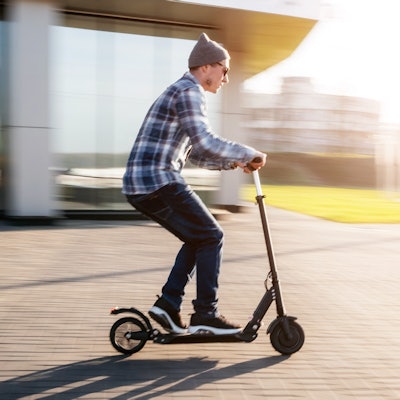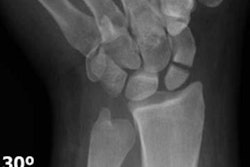
Should helmets be required for electric scooter use? Probably yes, say researchers from California, who identified a high proportion of head injuries on the emergency CT scans of scooter riders, many of whom were adolescents. The findings were published online January 25 in JAMA Network Open.
The group, led by first author Dr. Tarak Trivedi from the University of California, Los Angeles (UCLA), characterized the types of injuries associated with electric scooter use among patients who received care at two of the institution's hospital emergency departments. After examining the patients' x-ray and CT data, the researchers discovered that head injuries were the most common form of injury, occurring in more than 40% of the accidents.
Yet fewer than 5% of the patients claimed to have been wearing a helmet at the time of their scooter accident.
"While electric scooters are fun, convenient, and useful, they have the potential to cause significant injury," Trivedi told AuntMinnie.com. "Riders need to take safety seriously, and ... policymakers should focus on expanding bicycle lanes and ensure road maintenance; the roads are dangerous for scooter riders and cyclists, and riding on sidewalks is dangerous for pedestrians."
Scooting with impunity
The rapid rise of electric scooter use in recent years has spurred concern over how this new form of transportation could affect public health and safety, the authors noted. Companies offering dockless electric scooter rentals have reported exponential growth, yet there is no uniform set of policies to safeguard riders, with wide variation in enforcement of the few temporary measures in place.
 Dr. Tarak Trivedi from UCLA.
Dr. Tarak Trivedi from UCLA.At the time of the study, for example, electric scooter riders in California had to be at least 16 years old (compared with at least 18 years old by the standards of most scooter rental companies) and were required to wear a helmet. But the state of California passed a new law that made helmet use optional for adult riders as of January 1, 2019.
To understand the potential health risks associated with electric scooter use, Trivedi and colleagues retrospectively examined the cases of 249 patients who arrived at one of two emergency departments between September 1, 2017, and August 31, 2018, bearing injuries from electric scooter use. The average age of the patients was 33.7 years, and 58.2% were male.
The researchers found that a significant subset of injuries occurred in patients younger than 18, including one as young as 8 years old. The most frequent event was head injury (40.2%), followed by any kind of fracture (31.7%) and contusions, sprains, and lacerations beyond the head (27.7%). Approximately 94% of the patients were discharged home from the emergency department, and less than 1% had a severe injury requiring intensive care.
The majority of patients (80.3%) underwent CT or x-ray exams. The most common type of exam acquired was a distal upper extremity x-ray or CT scan, followed by head CT.
| Distribution of CT exams acquired for electric scooter injuries | |
| Region | Patients |
| Distal upper extremity* | 36.5% |
| Head | 29.7% |
| Distal lower extremity* | 20.1% |
| Cervical spine | 18.5% |
| Abdomen | 8.8% |
| Chest | 8.4% |
| Whole body | 8.4% |
Helmets protect heads
Among all injured electric scooter riders, only 4.4% were wearing a helmet when their accident took place. Trivedi and colleagues also performed an observational study in the local community and determined that only about 5.7% of electric scooter riders wore a helmet, even though California mandated helmet use during the study period.
A post-hoc analysis further revealed that more individuals presented to the two UCLA hospital emergency departments with electric scooter injuries (249 cases) than bicycle injuries (195) or pedestrian accidents (181) in the same time frame.
"This rapidly expanding technology is a disruptive force in short-distance transportation, and policymakers seeking to understand associated risks and appropriate regulatory responses should seriously consider its effects on public health," the authors concluded.
In a prior study covering a similar topic, Dr. Frederick Rivara and colleagues from the University of Washington reported that bicycle helmets were associated with an 88% reduction in the risk of traumatic brain injury. The consensus view of this and similar studies has spurred initiatives throughout the U.S. -- including requiring helmet use in certain cities and establishing dedicated bike lanes -- to decrease the risk of accidents, he noted in an accompanying editorial.
However, this work can be undone by electric scooters and similar devices, according to Rivara.
"The presence of so many unhelmeted users of two-wheeled vehicles may provide an example to bicycle riders to also forgo helmet use, potentially undoing two decades of work to increase helmet use by bicyclists," he wrote.
Electric scooter manufacturers and rental companies alike should develop and promote the use of helmets appropriate for electric scooters, Rivara wrote.
"Failure to do so is like a car rental company renting cars without seat belts. ... We as purveyors of healthcare and public health should partner with these other players to ensure that these companies are not creating a new public health problem," he concluded.



















